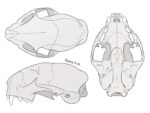Trophic ecology of Geoffroy’s cat (Leopardus geoffroyi) and mammal prey availability in semi-arid environments of central Patagonia, Argentina
Romina L. D'Agostino, Daniel E. Udrizar SauthierResearch on the dietary composition of felids can help improve the perception of rural workers and their tolerance towards this group, which is threatened by human-wildlife conflicts. In this context, the purpose of this study was to quantify the diet of Leopardus geoffroyi in Península Valdés (Patagonia, Argentina) to obtain baseline knowledge of the species’ dietary habits, trophic ecology, and degree of prey consumption. To this end, 160 fresh scat samples, collected from 2013 to 2016, were analyzed. Ten mammal species, one tinamou bird, one lizard genus, and one insect order were identified. The most frequently consumed prey (63.84%) were small-sized mammals (< 1 kg), accounting for the highest biomass contribution (37.2%). The frequency of each mammal species in the diet was not correlated with their capture frequency (measured through Sherman live traps and pedestrian diurnal transects). This study is the first to report on the diet of L. geoffroyi in Argentinean central Patagonia, and it provides information not only on ecological aspects but also on the natural history of this felid species.
Ecología trófica del gato montés (Leopardus geoffroyi) y disponibilidad de presas de mamíferos en ambientes semiáridos de la Patagonia central, Argentina. La investigación sobre la composición de la dieta de los felinos puede ayudar a mejorar la percepción y la tolerancia de los trabajadores rurales hacia esta especie de carnívoro felino que se ve amenazada por el conflicto entre humano-vida silvestre. En este contexto, el propósito de este estudio fue cuantificar la dieta de Leopardus geoffroyi en Península Valdés (Patagonia, Argentina) con la finalidad de obtener un conocimiento básico sobre la ecología trófica y el grado de consumo de presas. Para ello, se analizaron 160 muestras de heces frescas recogidas entre 2013 y 2016. Se identificaron 10 especies de mamíferos, una especie de tinamú, un género de lagarto y un orden de insecto. Se encontró que las presas consumidas con mayor frecuencia (63.84%) eran los mamíferos de pequeño tamaño (< 1 kg) que, a su vez, representaron la mayor contribución de biomasa (37.2%). La frecuencia de cada especie de mamífero en la dieta no se correlacionó con su frecuencia de captura (medida a través de trampas de captura viva tipo Sherman y transectos diurnos pedestres). Este trabajo es la primera aproximación a la dieta de L. geoffroyi realizada en la Patagonia central argentina y aporta conocimientos no solo sobre aspectos ecológicos, sino también sobre la historia natural de esta especie de felino.


